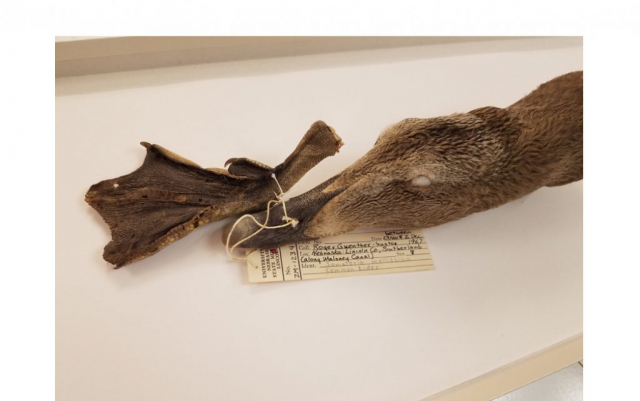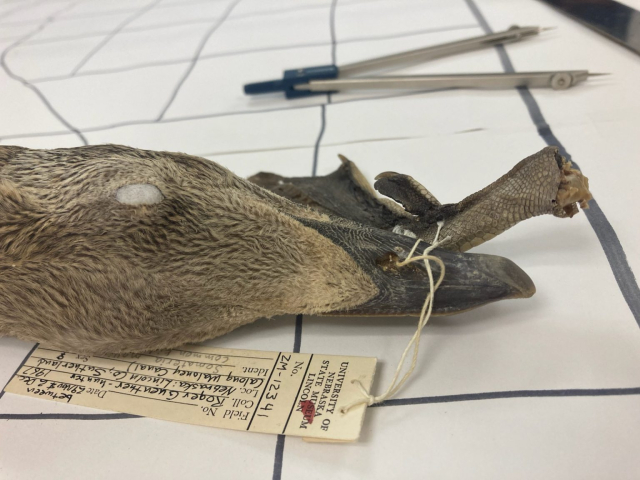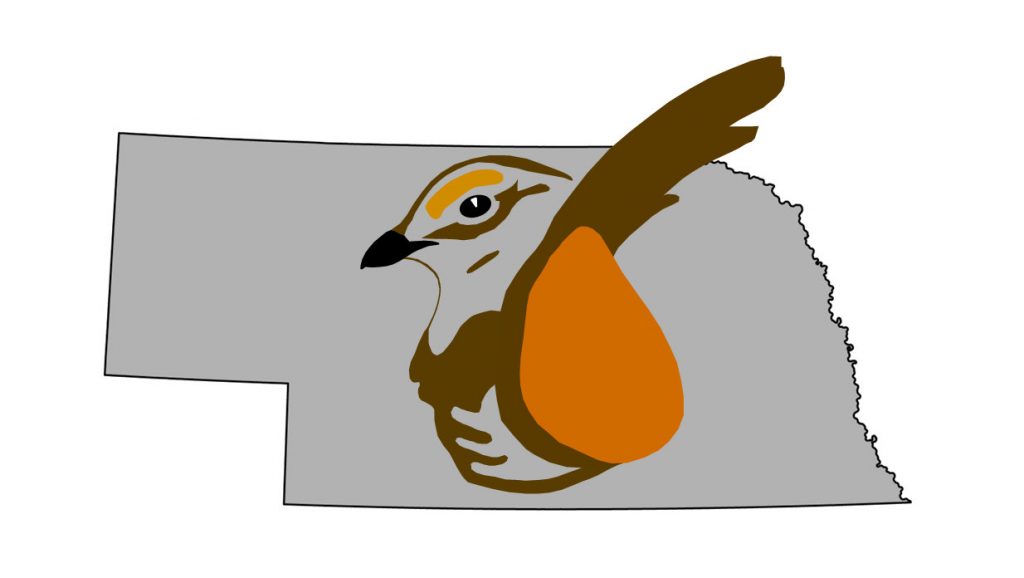Somateria mollissima V-NIGRUM
Status: Accidental in fall.
Documentation: Specimen: UNSM ZM12341, about 29 Nov-2 Dec 1967 Maloney Canal, Lincoln Co (Tate 1969, Manning et al 2024).
Taxonomy: Currently six subspecies are recognized (Gill et al 2022), four of which are native to North America: Pacific Common Eider S. m. v-nigrum, Atlantic Common Eider S. m. dresseri, Northern Common Eider S. m. borealis, and Hudson Bay Common Eider, S. m. sedentaria. Former subspecies islandica is merged with borealis (Goudie et al 2020).
The Nebraska specimen cited above was initially determined by Paul Johnsgard to be of the subspecies sedentaria (Tate 1969). However, this determination was recently (Aug 2022) questioned by Sam Manning, who noted the specimen’s bill processes do not appear consistent with sedentaria. Additional examination of the specimen, including collection of various bill measurements, confirmed Manning’s identification as v-nigrum (Manning et al 2024). Identification of Common Eider subspecies is discussed by Mendall (1986) and Able et al (2014).
Record: There is one record, the specimen cited above, which consists of a head and one foot. It was shot by a hunter and the remains brought to UNSM by Nebraska Fish and Game Department (now NGPC) personnel and prepared as a specimen by D. Jean Tate (Tate 1969).
A specimen collected 1 Nov 1901 near Sioux City on the Missouri River was identified as v-nigrum (DuMont 1934a, 1934b; Kent and Dinsmore 1996). Tate (1969) noted that this record could as well apply to Nebraska, as its site of collection is not accurately known (Silcock 1992); DuMont (1934a) noted that it was “Found in market. Brought in by hunter from Missouri River bottoms below city.”
Comments: The interior subspecies sedentaria is non-migratory, overwintering in polynyas in southern Hudson and James Bays, and thus unexpected as a vagrant in the Interior. Indeed, Mlodinow (1999) described the Nebraska record initially identified as this non-migratory subspecies so far from its usual haunts as “almost incredible.” This comment appears especially perceptive now that the subspecific identification of the Nebraska specimen was recently corrected to western v-nigrum (see Taxonomy).
Mlodinow (1999) noted there were 33 records of Common Eider in western North America, fully 30 of which were in the Interior, mostly between 15 Oct and 10 Dec on large lakes. Most of these are from Manitoba, Saskatchewan, North Dakota, and South Dakota; 19 of the 21 records from the western Canadian interior are from Saskatchewan and Manitoba (away from Hudson Bay) and seven of the nine records from the western United States are from the Dakotas but none from heavily birded Colorado or eastern California (Mlodinow 1999). Since 1999, however, there have been two records from California but still none from Colorado (eBird.org, accessed Apr 2023).
There is one Kansas record, a specimen of v-nigrum collected 3 Nov 1891 in northeastern Kansas (Thompson et al 2011), and two for Iowa, the Nov 1901 specimen for Woodbury Co discussed above, and one in Marion Co 27 Jan-18 Feb 1995, identified as v-nigrum (Dinsmore 1998). Based on three specimens, Common Eider is considered a casual fall migrant in South Dakota (Tallman et al 2002).
Images
Abbreviations
NGPC: Nebraska Game and Parks Commission
UNSM: University of Nebraska State Museum
Acknowledgement
Photograph (top) by Ross Silcock of a Common Eider head and foot (UNSM ZM12341) from a bird taken in Lincoln Co about 29 Nov-2 Dec 1967. The specimen is housed and maintained at the University of Nebraska State Museum and was legally salvaged or collected. We thank Thomas Labedz for facilitating the photographing of this specimen for the Birds of Nebraska – Online.
Literature Cited
Able, K, A. Barron, J. Dunn, K. Ornland, and L. Sansone. 2014. First occurrence of an Atlantic Common Eider (Somateria mollissima dresseri) in the Pacific Ocean. Western Birds 45: 90-99.
Dinsmore, S.J. 1998. Common Eider in Marion County. Iowa Bird Life 68: 105.
DuMont, P.A. 1934a. A revised list of the birds of Iowa. University of Iowa Studies. Studies in Natural History 15 (5), Iowa City, Iowa, USA.
DuMont, P.A. 1934b. Iowa specimen of the “American Eider” re-determined as the Pacific Eider. Wilson Bulletin 46: 203.
Gill, F., D. Donsker, and P. Rasmussen (Eds). 2022. IOC World Bird List (v 12.2). Doi 10.14344/IOC.ML.12.2. http://www.worldbirdnames.org/.
Goudie, R.I., G.J. Robertson, and A. Reed. 2020. Common Eider (Somateria mollissima), version 1.0. In Birds of the World (S. M. Billerman, Editor). Cornell Lab of Ornithology, Ithaca, NY, USA. https://doi.org/10.2173/bow.comeid.01.
Kent, T.H., and J.J. Dinsmore. 1996. Birds in Iowa. Publshed by the authors, Iowa City and Ames, Iowa, USA.
Manning, S., J.G. Jorgensen, S.J. Brenner, and W.R. Silcock. 2024. Correcting the record: subspecific identification of Nebraska’s lone Common Eider (Somateria mollissima). NBR 92: 128-131.
Mendall, H. L. 1986. Identification of eastern races of the Common Eider, in Eider ducks in Canada (A. Reed, ed.), pp. 82–88, Can. Wildlife Serv. Rep. Ser. 47. Supply and Services, Ottawa, Canada.
Mlodinow, S.G. 1999. Common and King Eider vagrancy in western North America. Birders Journal 8: 234-242.
Silcock, W.R. 1992. An additional Nebraska record of Common Eider? NBR 60: 149-150.
Tallman, D.A., Swanson, D.L., and J.S. Palmer. 2002. Birds of South Dakota. Midstates/Quality Quick Print, Aberdeen, South Dakota, USA.
Tate, D.J. 1969. Common Eider record for Nebraska. NBR 37: 38. Thompson, M.C., C.A. Ely, B. Gress, C. Otte, S.T. Patti, D. Seibel, and E.A. Young. 2011. Birds of Kansas. University Press of Kansas, Lawrence, Kansas, USA.
Recommended Citation
Silcock, W.R., and J.G. Jorgensen. 2025. Common Eider (Somateria mollissima sedentaria). In Birds of Nebraska — Online. www.BirdsofNebraska.org
Birds of Nebraska – Online
Updated 14 Mar 2025


